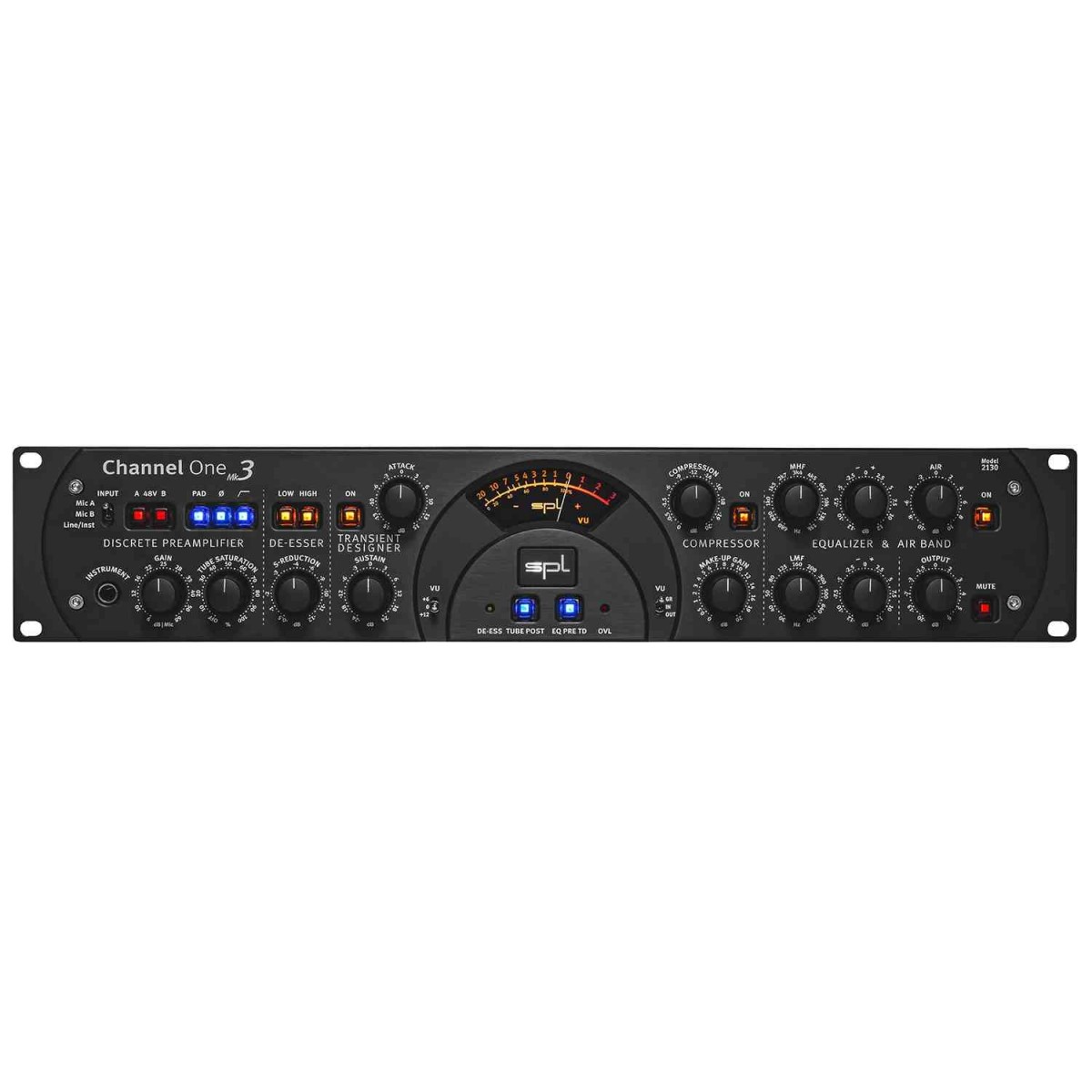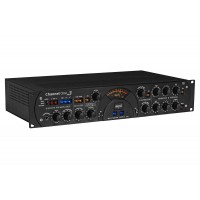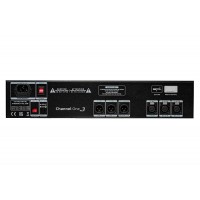- Studio & Recording
- Live Sound
- Room Acoustics
- Software & Plug-ins
- Guitars
- Bass
- Keyboards & Synthesizers
- Microphones
- Drums & Percussion
- DJ Equipment
- Accessories
SPL Channel One MK3
Product Code:
Availability:
Availability:
SPL Channel One MK3
Call for Availability
Call for Availability
Analog inputs & output; XLR & TRS Jack (balanced)
Maximum input gain (Mic)
21.5 dBu
Maximum input gain (Instrument)
14 dBu
Input impedance (Line)
20 kΩ
Input impedance (Instrument)
1 MΩ
Output impedance
100 Ω
Frequency range (-3 dB)
10 Hz – 100 kHz
Crosstalk (1 kHz)
-108 dBu
Noise (A-weighted, Mic Preamp, 150 Ω, 20 dB Gain)
-97.1 dBu
Noise (A-weighted, Mic Preamp, 150 Ω, 40 dB Gain)
-91.1 dBu
Noise (A-weighted, Mic Preamp, 150 Ω, 62 dB Gain)
-67 dBu
E.I.N. (150 Ω)
-129 dBu
Noise (A-weighted, Line/Instr Preamp, 600 Ω, 5 dB Gain)
-99.4 dBu
Noise (A-weighted, Line/Instr Preamp, 600 Ω, 20 dB Gain)
-97.2 dBu
Noise (A-weighted, Line/Instr Preamp, 600 Ω, 42 dB Gain)
-79.4 dBu
Common mode rejection (1 kHz)
80 dB
Internal Linear Power Supply with Shielded Toroidal Transformer
Operating voltage for analog audio
+/- 15 V
Operating voltage for relays and LEDs
+12 V
Tubes anode voltage
+250 V
Tubes heating voltage
+12.6 V
Phantom power
+48 V
Mains Power Supply
Mains voltage (selectable)
230 V AC / 50; 115 V AC / 60 Hz
Fuse for 230 V
T 315 mA
Fuse for 115 V
T 630 mA
Power consumption
max. 20 W
Dimensions & Weight
W x H x D (width x height x depth)
482 x 88 x 300 mm
19 x 3.46 x 11.8 inch
Unit weight
4.85 kg
10.69 lbs
Shipping weight (incl. packaging)
6.5 kg
14.33 lbs
PRODUCT DESCRIPTION
For over 20 years, Channel One has been a synonym for a high-quality and extremely musical recording and mixing channel strip. With the SPL Channel One Mk3 version, this classic has been thoroughly revised and, in addition to a higher internal audio voltage (now ±18 V) for even better, more detailed sound, a further improved preamplifier section, an integrated Transient Designer, a Tube Saturation stage and a Mic A/B comparison option for two microphones and other great features that raise the modern recording and mixing studio to a new level of quality. With de-esser, compressor and equalizer, all the important tools of a real channel strip are still on board. Whether it's a microphone, line, or instrument signal, the Channel One Mk3 makes any source sound like a professionally recorded signal. This design of the SPL Studio Series perfectly highlights the sonic qualities of this 3rd generation Channel One.
DISCRETE PREAMPLIFIER
Channel One Mk3 is equipped with one discrete preamplifier. The gain control can be used to adjust the preamplification. For microphone signals, a preamplification of up to 68 dB can be realized – so even really demanding microphones can show their qualities. The control range for line signals ranges between -20 dB and +16 dB. The control range for instrument signals ranges between -6 dB and +30 dB.
The Preamp Out picks up the signal directly after the microphone amplifier. This signal can also be recorded on a separate track in the DAW, for example, to be on the safe side. If it is noticed after a recording session that the singer was a little louder in the perfect take and therefore hits the compressor too hard, this incorrect setting can still be changed afterwards. The signal recorded for safety can later be played back into the Channel One Mk3 via the Line In and be processed there with Tube Saturation, Compressor or other tools.
TUBE SATURATION – MAGICAL TUBE SOUND
With this control the amount of tube saturation can be determined. The output level is accommodated automatically, in extreme settings the level increases by only 6 dB. Therefore decent to expressive harmonic distortions can be easily dialed in by turning just one knob.
Saturation effects are generated through the tube being pushed to and beyond its normal operating limits. In contrast to semiconductors, a tube thus pushed to such levels does not clip from a certain level, approaching more gradually its level limits and thereby producing its typical tonal result, which in audio signal processing can have such often profitable aural effects — on one hand (and depending on the amount applied), from subtle to extensive harmonic distortion and on the other hand, a compaction of the sonic event, that is, a limiting effect that exhibits a pleasant, rounded or soft sound. Acoustically and also in its range of applications this can be compared very well with tape saturation effects.
DE-ESSER
Unobtrusively and effectively, the Auto-Dynamic De-Esser removes distracting S‑sounds, in a mix or on vocal tracks, by detecting only the S‑frequencies, mixing them back into the main signal phase-inverted, and thus simply deleting sibilants in the original signal. The Auto-Threshold control maintains constant processing even as the singer’s distance from the microphone varies. The result is tonally neutral, unobtrusive and extremely effective. Even at high S‑reduction values, the de‑essing has no significant effect on the character and timbre of the voice.
TRANSIENT DESIGNER
With the Transient Designer it is possible to manipulate the envelopes of audio signals level-independently (no threshold!). Accelerate or slow down transients, lengthen or shorten sustain times – with just two controls: attack and sustain. All time constants are automated in a musical way and optimize themselves adaptively according to the characteristics of the input signal.
COMPRESSOR
The compressor is also extremely easy to operate with one knob only; its strength lies in its unobtrusive, musical operation. The Compression control can be used to set a threshold between 0 dB and -20 dB. The lower the threshold, the more the compressor works.
The Make-Up Gain control can be used to make up for the overall level reduction caused by compression. A value between 0 dB and 20 dB can be set by which the level is increased again after compression. With the help of the Gain Reduction display on the panel, the adjustment is very simple: if the maximum reduction value caused by the loudest part is e.g. -9 dB, the Make-Up Gain control should be set to values around +9 dB.
EQUALIZER
The center frequency of the half-parametric bass filter is set with the LMF control (low/mid frequencies). The adjustable frequency range is between 30 Hz and 700 Hz so that this filter covers a range of about 4.5 octaves, allowing it to be used from the deepest bass to the lower mid range.
The center frequency of the semi-parametric mid/high frequency filter is set with the MHF control. (MHF: mid/high frequencies). The frequency range can be set between 680 Hz and 15 kHz so that this filter covers a range of 4.5 octaves and can be equally employed in the lower mid as well as the high range.
SPL Audio Studio
ProMusicals © 2020
Made with ♡ by iTGS
ProMusicals © 2025











Reviews (0)